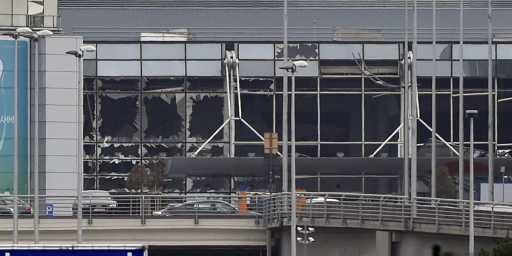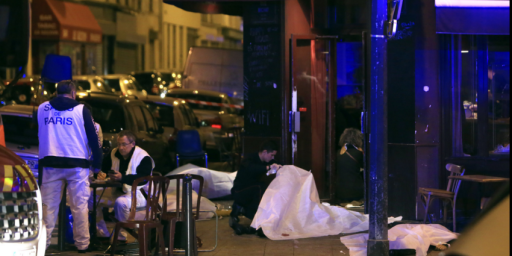London Underground Stations Evacuated after Explosion Reports
Two weeks to the day after al Qaeda terrorists hit the London subway system, there are reports of several small explosions.
3 London Underground Stations Evacuated (AP) CNN
Three London Underground stations were evacuated at midday Thursday following reports of incidents, British Transport Police said. The Fire Brigade was investigating a report of smoke at one station. Emergency services also were responding to a report of an incident on a bus in east London, police said. A London Underground spokesman said there were no reports of casualties in the unspecified incidents. The reports came two weeks to the day after attackers bombed three subway stations and a double-decker bus, killing 56, including four suicide bombers.
On Thursday, the Warren Street, Shepherds Bush and Oval stations were evacuated. Emergency services personnel were called to the stations, police said. “People were panicking. But very fortunately the train was only 15 seconds from the station,” witness Ivan McCracken told Sky news. McCracken said he smelled smoke at the Warren Street station, and people were panicking and coming into his carriage. He said he spoke to an Italian man who was comforting a woman after the evacuation. “He said that a man was carrying a rucksack and the rucksack suddenly exploded. It was a minor explosion but enough to blow open the rucksack,” McCracken said. “The man then made an exclamation as if something had gone wrong. At that point everyone rushed from the carriage.”
Services on the Victoria and Northern lines were suspended following reports of a number of incidents, the London Underground said. “I was in the carriage and we smelled smoke — it was like something was burning,” said Losiane Mohellavi, 35, who was evacuated at Warren Street. “Everyone was panicked and people were screaming. We had to pull the alarm. I am still shaking.”
Given that no deaths were caused despite several “incidents,” I’m inclined to doubt this was an al Qaeda operation. We should know the details soon enough, however.
Update: Wizbang’s Paul is live blogging the television and media coverage. Steven Taylor is rounding up the blog coverage.
Update 2: Blasts Hit 3 London Subway Stations, Bus (AP)
Explosions struck three London Underground stations and a bus at midday Thursday in a chilling but less deadly replay of the suicide bombings that killed 56 people two weeks ago. Only one person was reported wounded, but the explosions during the lunch hour caused major disruption in the city and were hauntingly similar to the July 7 bombings by four attackers.
The London police commissioner confirmed Thursday that four explosions took place in what he described as “serious incidents.”
“We’ve had four explosions_ four attempts at explosions,” Metropolitan Police Commissioner Ian Blair said outside police headquarters at Scotland Yard. “At the moment the casualty numbers appear to be very low … the bombs appear to be smaller” than the July 7 blasts.
Update 3: UK bombs meant as carbon-copy, may be same group (Reuters)
Four attempted bombings on London’s transport system on Thursday look like an intended carbon-copy of attacks that killed 56 people two weeks ago and may be masterminded by the same group, security analysts said. They put forward two main scenarios behind the latest blasts, which were much smaller than the previous ones, and did not cause any fatalities. The first, more benign explanation, was that the attacks were carried out by “imitative amateurs” intent on mounting a copycat strike by targeting three underground trains and a bus in a cross-formation across the city. The second, more worrying, was that the same group behind the suspected al Qaeda-linked attacks on July 7 had struck again, albeit with far less devastating effect.
[…]
Whoever was behind Thursday’s attacks, they managed to manufacture four explosive devices and smuggle them on to the London transport network despite the highest levels of security and public watchfulness in London for years. If the same group was responsible for two waves of coordinated attacks two weeks apart, it would show an alarming ease in mobilising fresh operatives — perhaps even would-be suicide bombers — to follow the example of the four bombers who blew themselves up on July 7. “The more we know about the bomb attack two weeks ago, the more skilful it looks, well planned — the people behind it know what they’re doing,” said Michael Clarke, security expert at King’s College London. “It is entirely plausible that they will have planned a campaign, not just one bomb. It’s part of terrorist psychology that one bomb is never enough.”
Former U.S. intelligence official Robert Ayers, a security analyst at respected London think tank, the Chatham House institute, said he thought it more likely the same group was behind both attacks than that a second, independent group had now emerged.
“What I’ve been saying all along is that you had four guys that died (in the July 7 bombings), but the infrastructure that trained them, equipped them, funded them, pointed them at the right target — the infrastructure’s still in place.” If the same group was involved, the obvious question is why the first wave of attacks was so professional and deadly and the second apparently so amateur.





Nothing to see here, folks. Move along